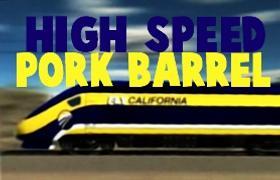 Excerpted from WSJ.com – Environmentalism may be religion to some on the left, but its high priests aren’t all pure and righteous. Consider the not-so-immaculate conception of California’s bullet train.
Excerpted from WSJ.com – Environmentalism may be religion to some on the left, but its high priests aren’t all pure and righteous. Consider the not-so-immaculate conception of California’s bullet train.
Last week, the state’s legislature authorized $4.7 billion in bonds to start construction on high-speed rail, which had been stalled in Sacramento for more than a decade due to logistical and political malfunctions. This train is now out of the station—though it’s almost certain to break down soon.
The project’s godfather is Democratic Congressman Jim Costa, who as a state senator in the 1990s wrote legislation creating California’s High-Speed Rail Authority and helped plan the 500-mile route between San Francisco and Anaheim. Before being elected to Congress (in 2004), he also authored a $10 billion state bond initiative to finance the project. Lawmakers in Sacramento postponed that initiative until 2008, fearing that California’s recurring budget crises would make it a hard sell.
But sell it they did. The rail authority promised voters that the train wouldn’t require a subsidy and that the feds and private sector would pick up most of the $33 billion tab. Expecting a free ride, voters leapt on board and approved the initiative in November 2008. Not long afterward, the authority raised the price to $43 billion.
Investors refused to plunk down money without a revenue guarantee—that is, a subsidy—from the state, which wasn’t forthcoming. California’s attorney general, whom we now call Gov. Jerry Brown, declined to investigate the bait-and-switch.
As soon as he took office, President Obama tried to help the state with $2.4 billion in stimulus money. A year and a half later—and two weeks before the 2010 midterm elections—the White House offered an additional $900 million, provided that the $3.3 billion sum be spent in the sparsely populated Central Valley. That is, in the congressional districts of Mr. Costa and fellow Blue Dog Democrat Dennis Cardoza, both of whom had provided critical votes for ObamaCare in March 2010 and were then in political peril.
The congressmen rode the subsidy train to re-election, flogging the 135,000 jobs that the construction would supposedly create in the Central Valley. To be sure, Mr. Costa denies trading his ObamaCare vote for high-speed rail money: “That’s not something I do,” he tells me. Besides, he says, the train “had already become unpopular by [the 2010 election],” so it couldn’t have accounted for his victory.
Actually, the train’s popularity didn’t plunge until 2011, when costs exploded to nearly $100 billion and the California Legislative Analyst’s Office (among others) warned that the first 130-mile segment would become a train to nowhere. Since congressional Republicans promised to zero out federal funding for high-speed rail, analysts noted, the state wouldn’t have enough money to electrify the tracks, let alone build out.
Meanwhile, many parties—farmers in the Central Valley and governments in the Valley’s Kings County and the tony liberal cities of Palo Alto, Menlo Park and Atherton—were suing the rail authority for not adequately addressing the train’s environmental impacts. Gov. Brown proposed shielding the train from such environmental lawsuits but abandoned the idea after the Sierra Club threw a tantrum.
The more people read and heard about the train, the more they disliked it. A string of Field and Los Angeles Times polls this year have shown that voters would block the train by a two-to-one margin if it were put up for a referendum. In 2008, 55% of voters approved the rail bond.
Souring public opinion started to give some Democratic legislators—particularly in the Bay Area and Los Angeles—cold feet. They threatened to waylay the train if their grievances weren’t addressed, chief among them that the rail authority and White House weren’t giving them their fair share. They wanted to milk the bullet train for whatever Democratic leaders thought their votes were worth.
But in Washington, Secretary of Transportation Ray LaHood had different plans. Two months ago, he threatened to claw back federal funding if Sacramento didn’t green-light construction before summer’s end. “We can’t wait,” he said. And why not? Because Republicans were threatening to claw back the money if they took the White House and Senate in November.
Mr. Brown used that threat to demand that legislators authorize $2.7 billion in state bonds before they adjourned this week. He sweetened the deal for Bay Area and L.A. legislators by adding $2 billion for regional rail projects. Included was $700 million to bail out—”modernize”—Silicon Valley’s insolvent Caltrain.
The governor rounded up just enough Democratic votes for passage. Four Democratic senators demurred, including Ventura County’s Fran Pavley, author of the state’s 2006 cap-and-trade law. She and two others faced tough re-election challenges.
The fourth nay vote came from Palo Alto’s Joe Simitian, who has sat on a high-speed rail subcommittee. He tells me he knew better since he “had ample opportunity to probe deeply” into the project. And other Democrats? “I’m sure they all felt fully informed,” he says unpersuasively.
“The whole thing was carefully staged to allow [dissenting Democrats like Mr. Simitian] to speak about their no votes just before their vote was taken. But Brown knew he had his 21 votes in his pocket,” says Bay Area economic analyst Bill Warren. Democrats gave their OK, he says, because they wanted money for local rail projects and construction jobs. “I doubt if any of them actually believe in their hearts that the rail system will ever be completed.”
Indeed, environmental lawsuits could block construction in the Central Valley or at least delay it for several years. The White House will no doubt send its regrets to Rep. Costa.
Regardless, the Bay Area and L.A. will likely get their pound of taxpayer flesh. Next year taxpayers will have to start paying interest on the rail bonds—about $380 million annually for the next 30 years—assuming investors bite. That’s nearly as much as the governor is proposing to cut from higher education if voters don’t approve his millionaires’ tax initiative in the fall.
This plundering of higher education should serve as a warning to voters who think that approving the millionaires’ tax will somehow save them from one day becoming sacrificial lambs on the government’s altar. Nothing is sacred.
– Read more of the Allysia Finley article at the WSJ.com.

